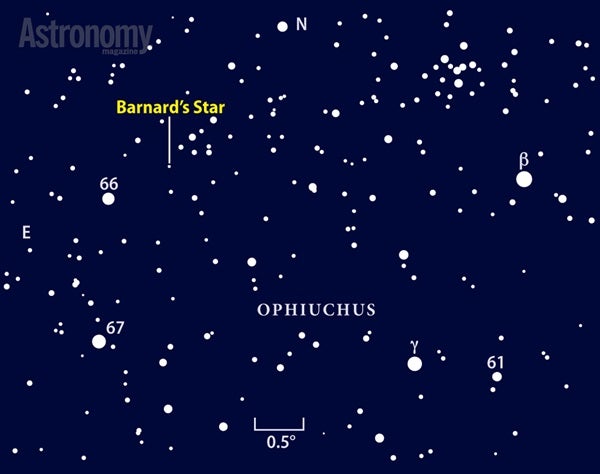My observations were of Barnard’s Star, named after Yerkes Observatory astronomer Edward Emerson Barnard (1857–1923). Barnard was a gifted visual observer whose keen eye uncovered, among other things, Jupiter’s moon Amalthea (the last moon discovered by visual means), more than a dozen comets, and the faint dwarf galaxy NGC 6822 (Barnard’s Galaxy). A pioneering astrophotographer, his extraordinary images of the Milky Way revealed several hundred dark nebulae and formed the basis of A Photographic Atlas of Selected Regions of the Milky Way, published after his death.
Barnard is perhaps best known for the discovery in 1916 of the rapid proper motion of the star that bears his name. Its tangential, or lateral, annual drift of about 10.4 arcseconds is greatest among all stars in our night sky and translates to a displacement equaling half the Moon’s apparent diameter in a human lifetime. Barnard’s Star is a runaway for two reasons: It’s close to us (at a distance of 6 light-years, it’s second in proximity to the Sun only to the Alpha Centauri system), and its orbital motion around the galaxy’s center far exceeds that of most stars.
Barnard’s Star also is moving toward us. Its combined lateral and line-of-sight movement equals a true velocity of 85 miles (137 kilometers) per second. It’s likely that Barnard’s Star came from another part of the galaxy and is passing through the solar neighborhood. In about 10,000 years, it will speed past the Sun at a distance of 3.85 light-years, tip its cap, and proceed onward into parts unknown.
Red dwarfs constitute the bulk of the main sequence denizens of the galaxy, making up an estimated two-thirds to three-fourths of the entire stellar population. What they lack in size, they make up for in longevity. Because of their small mass and resulting low inward gravity pull, red dwarfs expend their hydrogen fuel far more economically than do more massive stars. A blue supergiant like Rigel will last about 10 million years before possibly being snuffed out in a type II supernova explosion. The Sun, an average-sized G-type star, has a life expectancy of 10 billion years, half of which has already transpired. Although twice as old as the Sun, Barnard’s Star is still in its infancy and will continue shining for as many as 3 to 4 trillion years. To put things in perspective, if Barnard’s Star had a 75-year human life expectancy, the Sun would endure for less than three months and mighty Rigel would survive for about two hours!
Barnard uncovered the proper motion of his star a century ago; I captured it some 30 years ago. Now it’s your turn! Use the StarDome at the center of this issue to find Beta (β) Ophiuchi in your May sky, and then use the star chart above to help you locate Barnard’s Star. As accurately as possible, sketch its position relative to nearby field stars, concentrating on those to the north, the direction Barnard’s Star is moving. If you’re an astroimager, be sure to include the area where Barnard’s Star will be when you make your follow-up image. Keep your sketch or image in a safe place. A year or two from now (for imagers) or five to 10 (for sketchers), make your follow-up observation. Let’s just hope it doesn’t coincide with the next clear night from your locale!
Questions, comments, or suggestions? Email me at gchaple@hotmail.com. Next month: Happy Asteroid Day! Clear skies!











